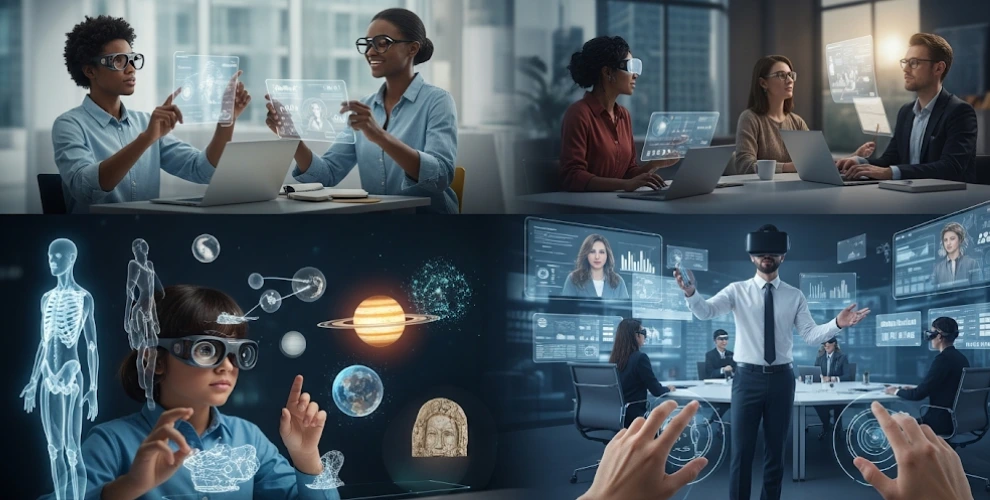
Is AR and VR Technology Changing the Way We Learn, Work, and Play in 2025?
Table of Contents
Introduction
Welcome to WikiGlitz!
If you’ve been wondering how emerging tech is reshaping your everyday life, you’re not alone. In 2025, AR and VR technologies have expanded beyond just gaming.
From virtual classrooms to construction sites and remote team collaboration, the way we learn, work, and play is undergoing a digital revolution.
In this blog, we’ll answer some of the most pressing questions about how augmented and virtual reality are transforming our world.
Key Takeaways
- AR and VR technology is no longer niche—it’s transforming sectors like education, work, and construction.
- Tools like augmented reality glasses and AR headsets are becoming more affordable and practical for mainstream use.
- Understanding real-world applications gives users a clearer path to adopt this technology wisely.
What is AR and VR Technology, and Why Is It Important in 2025?
AR and VR technology refers to systems that merge or simulate realities.
- Augmented Reality (AR) enhances the real world by overlaying digital content, such as through AR glasses.
- Virtual Reality (VR) offers a fully immersive experience within a digital environment.
In 2025, the importance of these tools lies in their accessibility, cost reduction, and practical applications across sectors like education, construction, retail, and healthcare.
How Are Augmented Reality Glasses Being Used Today?
Augmented reality glasses are intelligent wearable gadgets that project digital information onto your real-world view. In 2025, they’re widely used in:
- Education: Teachers use them to bring science experiments or historical reenactments into classrooms.
- Healthcare: Surgeons use real-time guidance during complex operations.
- Retail: Shoppers can view product info and try on virtual clothing.
Some of the best augmented reality glasses now include eye-tracking, voice command features, and lightweight frames, making them suitable even for everyday users.
Which Augmented Reality Companies Are Leading in 2025?
Top augmented reality companies are no longer just tech giants. While tech giants like Microsoft (HoloLens) and Apple (Vision Pro) push the boundaries of innovation, emerging companies such as Magic Leap, RealWear, and Vuzix are delivering specialized solutions tailored to specific industries.
These companies focus on:
- Lightweight AR headsets for field workers
- Educational platforms with AR and VR technology integration
- AR apps that improve collaboration in remote teams
What Is an AR Headset and How Does It Differ from VR?
An AR headset adds digital information to your real-world surroundings, while VR headsets completely immerse you in a virtual environment.
Use cases of AR headsets include:
- Remote technical support (field engineers seeing live annotations)
- Training simulations for manufacturing
- Gaming with physical movement and surroundings
In contrast, VR is better for isolated experiences, such as virtual meetings or 3D design visualization.
How are AR and VR Used Together in 2025?
The term AR VR refers to technologies working together or interchangeably.
For example:
- An employee uses VR to train for a complex task and later uses AR on-site for real-time assistance.
- Students attend immersive VR lectures and use AR glasses for follow-up activities in labs.
This blended approach enhances learning retention, ensures safety, and increases productivity across various fields.
Is Augmented Reality in Construction Really Useful?
Yes. Augmented reality in construction has become a game-changer in 2025.
Here’s how:
- Engineers overlay blueprints on physical sites using AR headsets, reducing errors.
- Project managers use AR to inspect safety compliance and material placement.
- Clients can do AR walkthroughs of completed structures before building begins.
This reduces costs, increases speed, and improves communication between all stakeholders.
What Are the Best Augmented Reality Glasses in 2025?
Choosing the best augmented reality glasses depends on your needs. Here are top picks:
- Apple Vision Pro – high-end, sleek, ideal for enterprise and personal use
- Vuzix Blade 2 – ideal for professionals in the field and remote support applications
- Snap Spectacles 4.0 – social and entertainment-focused
- Lenovo ThinkReality A3 – ideal for learning and teamwork
All these offer improved battery life, user interfaces, and third-party app integration in 2025.
How Is Augmented Reality in Education Changing Classrooms?
Augmented reality in education is arguably one of the most transformative uses of AR and VR technology in 2025.
- Interactive learning: AR visualizations help students understand abstract concepts like gravity or DNA.
- Field trips without leaving the room: VR takes students on virtual museum tours or space walks.
- Teacher productivity: Lessons can be recorded in AR/VR and reused.
Countries like the US, Germany, and Canada are seeing improved student engagement and better test performance through these tools.
Is the AR Headset Market Accessible to Everyone?
AR headsets are now available from ₹15,000 to ₹1,00,000+, making them accessible for:
- Students
- Small businesses
- Hobbyists
Previously dominated by enterprise users, budget models now allow everyday users to explore AR and VR technology for learning, gaming, and productivity.
Are There Any Downsides to AR and VR Technology?
While the benefits are significant, challenges remain:
- Hardware cost: Premium devices are still expensive.
- Battery and comfort: Extended use may cause eye strain or feel heavy.
- Privacy: Devices that record or process real-time visuals raise concerns.
Still, as innovation continues, most of these barriers are being addressed year over year.
How Can You Get Started with AR and VR in 2025?
Getting started is easier than ever:
- Choose an affordable AR headset or augmented reality glasses.
- Try beginner apps—educational, home design, or productivity.
- Follow tutorials and communities online.
- Look out for platforms supported by top augmented reality companies.
If you’re an educator, builder, gamer, or just curious, 2025 is the best time to explore AR and VR technology.
Conclusion
Finally, at WikiGlitz, where tech meets transformation. As we’ve seen, AR and VR technology in 2025 is no longer just about virtual gaming.
It’s a practical tool powering classrooms, improving job sites, and making learning and living more immersive than ever.
Whether you’re an educator in Canada, an engineer in Germany, or a student in the UAE, it’s time to step into the augmented era.
Follow WikiGlitz for more such insights on how emerging technologies are shaping our future.
Frequently Asked Questions
1. What is the difference between AR and VR technology?
AR (Augmented Reality) overlays digital elements onto the real world using devices like augmented reality glasses, while VR (Virtual Reality) immerses users in a completely simulated digital environment using headsets. AR enhances reality; VR replaces it.
2. How are Augmented Reality (AR) and Virtual Reality (VR) being applied in education in 2025
AR and VR technology in education enables interactive learning, virtual field trips, 3D science models, and immersive simulations. Tools like AR headsets and VR classrooms help students grasp complex concepts better and increase engagement.
3. Are augmented reality glasses affordable in 2025?
Yes, in 2025, augmented reality glasses range from entry-level options under ₹20,000 to premium models over ₹1,00,000. Many offer features like gesture control, voice assistance, and app integration suitable for work, learning, and daily use.
4. What are the practical uses of AR in construction?
Augmented reality in construction helps overlay blueprints on real-world structures, improves on-site error detection, enables AR walkthroughs, and enhances safety checks—all leading to faster, cost-effective project delivery.
5. Which companies will lead the AR and VR space in 2025?
Top augmented reality companies in 2025 include Apple (Vision Pro), Microsoft (HoloLens), Magic Leap, Vuzix, and RealWear. These firms develop cutting-edge AR headsets and applications for education, construction, healthcare, and enterprise use.





